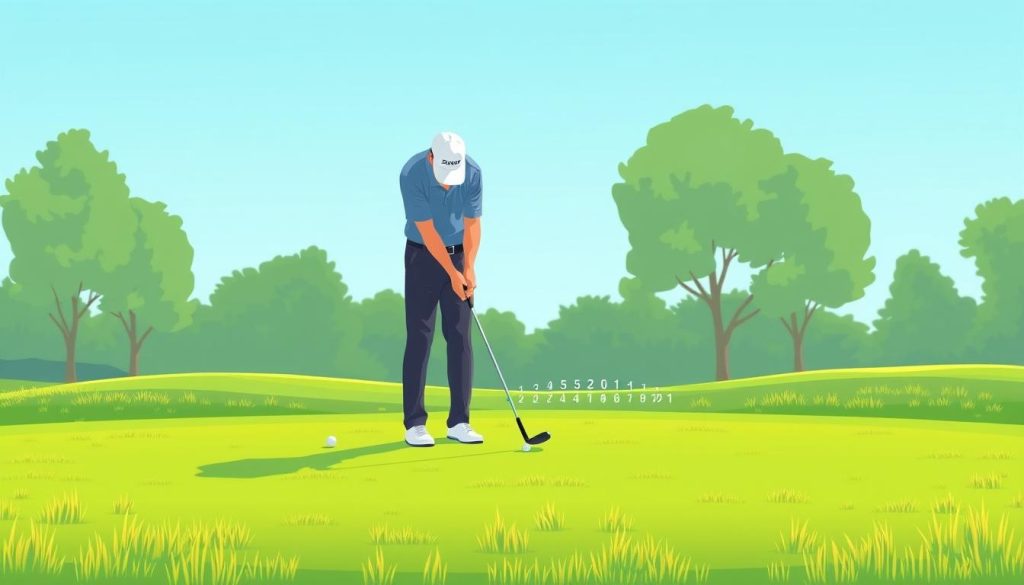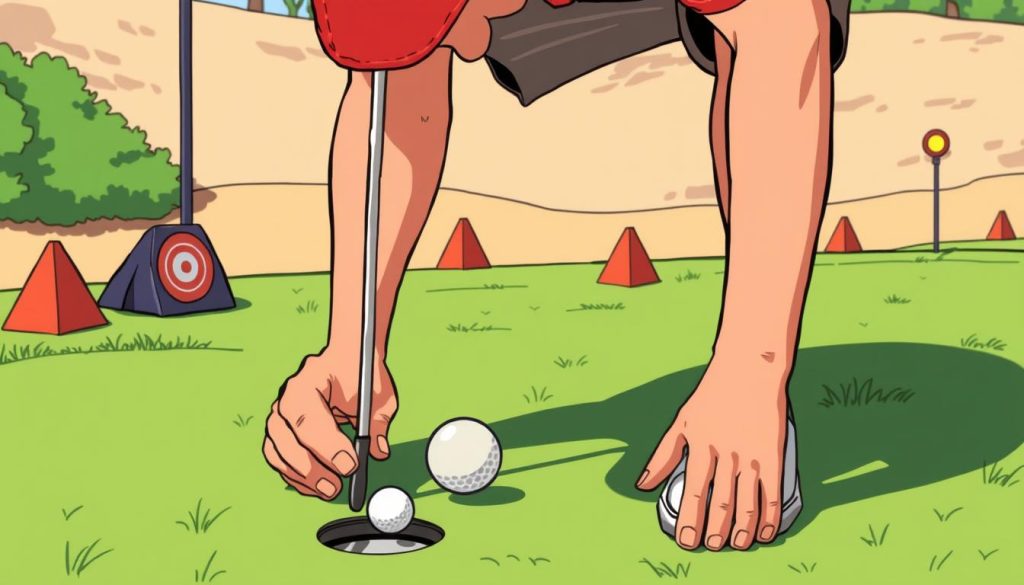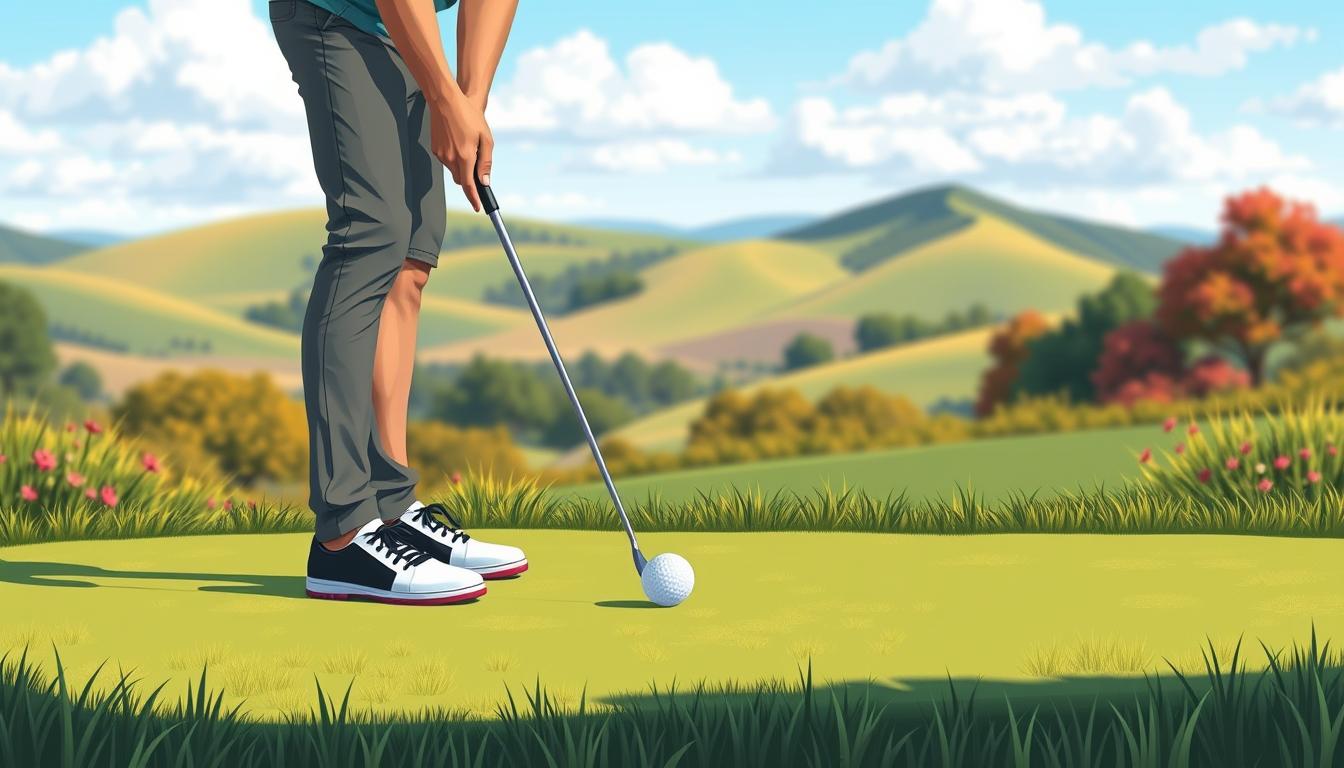Golf putting technique is key to a strong short game. This guide covers the basics of stroke mechanics and green reading. It’s perfect for beginners or those looking to improve their game.
Learning the short game starts with the basics of putting. You’ll discover how to stand, grip, and align properly. Plus, you’ll learn to read greens well.
This guide also talks about advanced techniques like the AimPoint Method. It’s a system by Mark Sweeney for estimating green slopes with your hands.
To get better at putting, practice specific drills. Try the Gate Drill, Distance Control Drill, and String Line Drill. They help improve your stroke and confidence on the green.
Key Takeaways
- Proper stance, grip, and alignment are crucial for consistent putting
- Green reading skills are essential for accurate putts
- The AimPoint Method helps estimate green slopes
- Practice drills improve stroke mechanics and consistency
- Choosing the right putter type and brand can enhance performance
- Indoor putting greens offer convenient practice opportunities
Understanding the Fundamentals of Golf Putting
Golf putting is key to a good game. Learning the basics can greatly improve your green performance. Let’s explore what makes a great putt.
What Makes a Perfect Putt
A perfect putt needs aim, speed, and a smooth stroke. Getting your alignment right is hard for many. Tools like mirrors or strings can help with your aim.
The Role of Speed, Aim, and Stroke
Speed controls how the ball moves on the green. Aim is about predicting the ball’s path. Your stroke, including grip and follow-through, is also important. Analyzing your putting can show you how to get better.
Essential Equipment Components
Choosing the right putter is vital. Look at the type, length, weight, and balance. A 33-inch putter is best for those around 6 feet tall.
| Equipment Factor | Recommendation |
|---|---|
| Putter Length | 33 inches for 6ft tall golfer |
| Weight Distribution | 75% on left heel |
| Ball Position | 2 inches inside left heel |
| Grip | Thumbs on top, index finger under shaft |
Success in putting comes from preparation. Spend time reading the green and trust your vision. Keep your head steady and your right wrist angle consistent for better results.
Mastering the Art of Green Reading
Green reading skills are key to a good putting technique. They help you understand the putting surface better. This can greatly improve your golf game. Let’s look at important aspects of green reading to boost your game.
Visual Assessment Techniques
To read greens well, start by looking at the surface from different angles. Notice any small slopes or changes in the ground. Shadows can make these slopes look bigger.
Every putt has a “high point” where it starts to curve towards the hole. Keep this in mind when you’re on the green.
Understanding Slope and Grain
Grass grain affects how your ball rolls. Putts against the grain are slower, while those with the grain are faster. The plumb-bob method helps you see the green’s slope.
Remember, faster putts break less, and slower ones break more. This is important for your putting strategy.
The AimPoint Method
The AimPoint method, by Mark Sweeney, is a detailed way to read greens. It uses your feet and hands to show the slope and aim. It takes practice but can make your putting more accurate.
| Technique | Key Benefit | Difficulty Level |
|---|---|---|
| Visual Assessment | Comprehensive overview | Easy |
| Plumb-bob Method | Precise slope reading | Moderate |
| AimPoint Method | Systematic approach | Challenging |
| Vector Putting | Mathematical precision | Advanced |
Getting good at green reading takes time and effort. By practicing these techniques, you’ll get better at reading greens. Remember, patience is key to improving your green reading skills and your golf game.
Putting Stroke Coaching Guide
Mastering your putting stroke is key to lowering scores and improving your short game. This guide focuses on essential elements to enhance your putting technique. Follow these tips to develop a consistent and effective stroke.
Golf coaching experts stress the need to limit wrist movement in your stroke. Tour players keep their wrists still for better consistency. Amateurs often struggle with varying wrist movements. To control better, keep your wrists stable throughout the stroke.
Tempo is crucial for putting success. Great putters have a 2:1 backswing to downswing ratio. Aim for a swing speed of 72-80 beats per minute. Using a metronome can help you develop this rhythm and improve distance control.
Grip consistency is vital in putting. Make sure your hand placement and grip pressure are the same for every putt. This consistency greatly improves your putting stroke’s reliability.
| Putting Element | Importance | Practice Tip |
|---|---|---|
| Wrist Movement | High | Use a wrist sensor for feedback |
| Tempo | Critical | Practice with a metronome |
| Grip Consistency | Essential | Use a grip trainer |
| Face Control | Crucial | Practice with alignment sticks |
| Smooth Transition | Important | Use a putting mirror |
Understanding your putting path is vital for short game instruction. Whether you prefer a straight-back-straight-through or an arc stroke, consistency is key. Practice with a putting string to improve your stroke accuracy.
Face control is crucial in putting. Make sure your putter face is square to the target at impact for straight putts. Use drills with alignment sticks to perfect your face angle control and boost your putting performance.
Perfecting Your Putting Setup Position
A solid putting technique starts with the right setup. This step is key for a consistent and accurate putt. Let’s explore the essential elements of a perfect putting position.
Proper Stance and Posture
Stand with your feet shoulder-width apart for balance. Bend from the waist until your eyes are directly over the ball. This posture helps you move smoothly in your putting stroke. Some golfers like a slightly open lead foot, but a square setup is usually best.
Eye Position Over the Ball
Correct eye positioning is crucial. Most putters have a 2-4 degree loft for the best roll when your eyes are aligned with the ball. Try this test: hold a second ball at eye level and drop it. If it hits the first ball, you’re in the right spot.
Grip Pressure and Hand Placement
Your grip affects your putting stroke. Try different styles like the traditional overlap, cross-handed, claw, or reverse overlap grip. Keep your grip pressure light and consistent. Your arms should form a triangle with your chest, staying this way during your stroke.
| Grip Style | Benefits | Popular Among |
|---|---|---|
| Traditional Overlap | Familiar, promotes feel | Many amateur golfers |
| Cross-handed | Reduces wrist movement | Players seeking stability |
| Claw | Enhances stability and control | Increasing number of pros |
| Reverse Overlap | Improves control and security | Golfers wanting a firm grip |
Remember, putting is both art and science. Practice these setup basics to develop a consistent stroke. With time, you’ll naturally find the perfect putting position, improving your game on the greens.
The Science of Stroke Mechanics
Understanding the science behind putting stroke mechanics is key to improving your golf game. Golf swing mechanics play a crucial role in achieving consistent and accurate putts. Let’s dive into the biomechanics analysis of a putting stroke to help you refine your technique.
The putting stroke involves a pendulum-like motion of the shoulders. This rocking action maintains steady body movement and light grip pressure. A rhythmic stroke with a firm finish and minimal wrist movement ensures square contact with the ball for successful putts.
Proper alignment of the putter face at setup is vital. The key principles for effective putting involve ensuring the putter face is aligned squarely at setup and returns squarely at impact. Even a slight error can have significant consequences. For example, a 5-foot putt with just one degree of error could result in missing the hole.
Arm positioning plays a vital role in creating a cohesive stroke. Keep your arms, hands, chest, and shoulders working together for a successful putting stroke. Maintain a consistent grip to avoid inconsistencies and improve accuracy.
| Aspect | Importance |
|---|---|
| Putter face alignment | Crucial for accuracy |
| Center face contact | Optimal roll and distance |
| Weight balance | Prevents swaying during stroke |
| Arm positioning | Creates cohesive stroke |
Remember, the tempo of your putting stroke is crucial. Maintain a smooth backstroke and through-swing to enhance distance control and accuracy. By focusing on these biomechanical elements, you’ll be well on your way to mastering the art of putting.
Tempo and Rhythm in Putting
Mastering tempo and rhythm is key to better putting. Golf coaches stress the need for a steady stroke for top performance. Let’s dive into the important aspects of tempo and rhythm in putting to improve your game.
The 2:1 Ratio Principle
The 2:1 ratio is a basic rule in putting. Your backstroke should last twice as long as your forward stroke. Keeping this ratio helps you perform consistently, no matter the putt length. Pros often have a tempo of about 100 beats per minute, showing a quick yet steady rhythm.
Using Metronome Training
Metronome training is great for a consistent putting tempo. Use a metronome set between 85-110 beats per minute to improve your stroke rhythm. This method helps golfers get better timing and boosts confidence on the greens. The Tour Tempo app also helps keep the 2:1 ratio and offers different speeds.

Distance Control Through Tempo
A steady tempo is crucial for controlling distance in putting. Keeping a consistent rhythm helps manage speed and boosts accuracy. Try the ‘Trust It’ Putting Tempo Drill to improve aim and distance control from 15-30 feet.
| Tempo Component | Description | Impact on Performance |
|---|---|---|
| Shoulders | Key movement in stroke | Enhances consistency |
| Forearms | Contributes to smooth motion | Improves stroke control |
| Wrists | Maintains stability | Increases accuracy |
Adding these tempo and rhythm techniques to your practice can cut down on putts per round. It can also improve your overall golf game. Remember, a consistent tempo is the heart of effective putting, affecting both your physical skills and mental game.
Advanced Putting Stroke Techniques
Learning advanced putting techniques can boost your short game and golf coaching. These skills help you improve your putting for better results on the green.
Brad Faxon, a top putter, suggests a 2:1 backswing to downswing ratio for a smooth stroke. He also recommends matching putter length to your wrist crease for better control. Keep your grip light to let the putter swing freely.
Stance can differ among golfers. Faxon uses a slightly open stance due to his right-eye dominance, helping him see the line better. Try different stances to find what works for you.
Dave Stockton, another putting expert, stresses the role of feel in your stroke. He advises right-handed golfers to use their right hand for power and feel. The left hand should keep the putter-head low at impact.
Stockton suggests breaking your putt into three parts, focusing more on the last third. This is where the ball slows down and is more affected by slope. This method can greatly improve your accuracy on tough greens.
To improve your putting, try these advanced drills:
- Use a small target like a dime for audible feedback
- Practice exaggerated swings to reduce nerves
- Focus on a spot close to the ball rather than a distant target
- Visualize your putt before stroking
Remember, staying relaxed and confident is crucial for mastering these advanced techniques. With regular practice and good coaching, you’ll see big improvements in your short game.
Essential Practice Drills and Methods
Mastering the art of putting takes dedication and focused practice. Let’s look at some effective drills and techniques for the short game. These can help improve your performance on the green.
Gate Drill Implementation
The Gate Drill is a key part of putting practice. Place two tees or golf balls wider than your putter head, making a ‘gate’. Your aim is to putt through this gate without hitting either side. This drill helps you improve your aim and maintain a straight stroke.

String Line Training
String Line Training is vital for a consistent stroke. Use a string or laser line to mark a straight path from your ball to the hole. Practice putting along this line to develop a square putter face and a straight stroke.
Path Length Control Exercises
Controlling distance is crucial to avoid three-putts. Try the Tee Ladder Drill: set up tees at 5, 10, and 15 feet apart. Putt to each distance, adjusting your stroke length. This drill helps you feel different distances and manage green speeds.
| Drill | Purpose | Potential Improvement |
|---|---|---|
| Gate Drill | Improve aim and stroke path | Up to 80% accuracy increase |
| String Line Training | Enhance stroke consistency | 70-90% improvement in path accuracy |
| Tee Ladder Drill | Develop distance control | 60-75% better distance judgment |
Adding these drills to your routine can greatly improve your putting. Remember, consistency is crucial in the short game. Regular practice will boost your confidence and enhance your putting skills.
Mental Game Strategies for Putting
Mastering the mental game is key for putting success. Golf coaches stress the need for mental prep in performance psychology. Let’s look at strategies to boost your putting skills through mental coaching.
Pre-Putt Routine Development
Having a consistent pre-putt routine boosts focus and confidence. Start by checking the green, imagining your putt, and taking a deep breath. This routine quiets your mind and gets you ready for a great stroke.
Visualization Techniques
Visualization is a strong tool in golf coaching. Imagine the ball’s path and a successful outcome before each putt. Research shows 85% of pro golfers use visualization, leading to better performance.
Pressure Management
Handling pressure is vital in performance psychology. Use breathing exercises and positive self-talk to stay calm under stress. Golfers who use their “athletic mind” make 30% more successful putts than those using their analytical mind.
| Mental Strategy | Success Rate |
|---|---|
| Visualization | 85% |
| Athletic Mind Engagement | 30% improvement |
| Green Reading Practice | 25% higher success |
Use these mental game strategies in your putting practice. Remember, 78% of top golfers rely on their subconscious mind during putting. By focusing on mental coaching, you’ll see big improvements in your golf game.
Conclusion
Putting stroke coaching is key for improving your golf, especially in the short game. Focus on the basics and practice often to boost your putting. Think about Hana Wakimoto’s 51 putts in two rounds at the LPGA TOTO Japan Classic. With hard work and the right technique, you can reach that level too.
Try drills like the Putting Arcade and Treasure Hunt Challenge to get better. These make practice fun and prepare you for real games. Pay attention to your stroke tempo for a consistent roll. Look at John E. McCray’s turbo putting in disc golf for inspiration and try different styles to find what suits you.
When planning your putts, think about wind, elevation, and temperature. Pick your line wisely and stick to it. A pre-putting routine and regular practice will greatly improve your short game. Remember, it’s not just about technique. It’s about gaining confidence and being consistent on the green.
FAQ
What is the ideal tempo for a putting stroke?
How can I improve my green reading skills?
What is the proper setup position for putting?
How can I practice putting under pressure?
What are some effective putting practice drills?
How do I choose the right putter for my game?
What role does wrist motion play in the putting stroke?
How can I improve my distance control in putting?
Source Links
- https://skillest.com/blog/master-the-art-of-golf-putting-a-comprehensive-guide-for-beginners/
- https://www.pga.com/story/get-better-at-putting-try-these-six-tips-to-improve-your-stroke?srsltid=AfmBOooymjc2WXgAJkJM3kOqoW-eyiwUTWIBJWkw9hpEzBwz8q_vCG0G
- https://www.scienceandmotion.com/download/docs/fundamentals/The Fundamentals of Putting1.pdf
- https://www.pga.com/archive/basics-putting?srsltid=AfmBOorxOvg5u5yqDqKHIzEvToqvucoQQ7Dk4qaF4cAcDxgwOfccOM6E
- https://www.golfzonleadbetter.com/blogs/putting-tips-how-to-read-a-green/
- https://skillest.com/blog/mastering-vector-putting-techniques-for-improved-accuracy-on-the-green/
- https://www.pga.com/story/get-better-at-putting-try-these-six-tips-to-improve-your-stroke?srsltid=AfmBOoryYLWWYlouZ-roO3Hofci6BZM5l7qzFOpmPo0e8g4g70ciiasE
- https://hackmotion.com/putting-stroke-tips/
- https://usgolftv.com/instruction/putting-golf-tips/5-keys-to-a-proper-putting-setup/
- https://swingtrainer.com/blogs/instruction/putting-stroke-technique-tips?srsltid=AfmBOopCC3TCYMhWNJXP3TAAuidGH3M4P3K5eRyrE10nFhttMELtqkmX
- https://puttingworld.com/perfecting-your-putting-grip-and-technique/
- https://us.humankinetics.com/blogs/excerpt/putting-techniques?srsltid=AfmBOooRGsZowyG_G9oD5y_ZZG5Y9HN-TcLs9NLuutfyWrqVBjxUvyaV
- https://www.todays-golfer.com/features/instruction-features/2020/september/phil-kenyon-golf-putting-tips/
- https://swingtrainer.com/blogs/instruction/putting-stroke-technique-tips?srsltid=AfmBOorHOUscXQR0NKJ-zajTE2cjF297WSjpLl3NLwqQfhWrswLqfIbJ
- https://cattailcrossing.ca/blog/putting-tempo-the-rhythm-of-better-putting/
- https://theleftrough.com/putting-tempo/
- https://aliorchardgolfcoaching.com/putting-tempo-drills-to-practice/
- https://skillest.com/blog/putting-like-brad-faxon-tips-to-improve-your-putting-stroke/
- https://alamocitygolftrail.com/dave-stocktons-all-time-top-ten-putting-tips/
- https://hackmotion.com/putting-drills-for-speed/
- https://swingtrainer.com/blogs/instruction/putting-stroke-technique-tips?srsltid=AfmBOopMOgM25P2fJ7oz5SVefc1oMM8v3D4ba8NGek31wFJ5atxPG65i
- https://superstrokeusa.com/blogs/blog/phil-kenyon-putting-tips?srsltid=AfmBOooljNiZTU8TFofVRvk_y4Jue6vQp7k3cc851JE876Aw3XgIz5hS
- https://golfstateofmind.com/the-art-of-putting-a-pure-mental-game/
- https://www.puttingyips.com/2011/six-mental-game-tips-for-confident-putting/
- https://www.pga.com/story/get-better-at-putting-try-these-six-tips-to-improve-your-stroke?srsltid=AfmBOoqkC0EwvV6gP8S8ZzOtTtyOXrp5hSq5KoK9RiGNauHOzPHw4MXx
- https://www.dgputtheads.com/disc-golf-putting-tips


